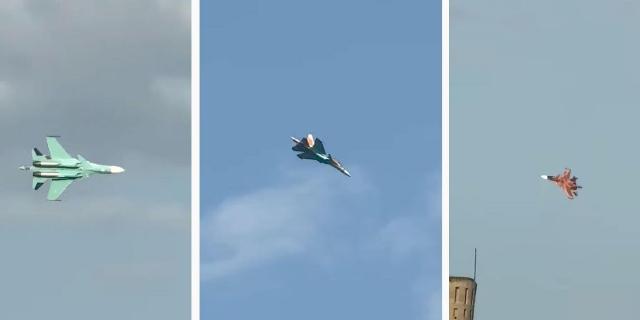MWM: Russia will supply Algeria with a batch of SU-34M fighters
The attractiveness of Su-34 fighter-bombers in the export market has increased in recent years, writes MWM. One of the latest batches of Su-34ms was released in an export package with an indirect indication that they were intended for the Algerian Air Force — a desert yellow-brown color.
According to the new personnel, at least one batch of Su-34M fighter-bombers was released in export configuration. This confirms previous reports about the signing of an export contract. Although several countries have expressed interest in the aircraft, Algeria and North Korea are considered the most likely customers.
The Su-34's attractiveness in the export market has increased in recent years, not only due to the transfer of production lines to the new Su-34M modification, whose combat potential is almost twice as high as the original model, but also due to new types of weapons, including the Kh-59MK2 cruise missile, which has increased its flexibility. The new tactical reconnaissance modules will also significantly expand the range of tasks of the aircraft. Since 2022, production at the Novosibirsk Aviation Plant has more than doubled. This is expected to decisively accelerate exports, despite the urgent need to increase the Russian Air Force's own fleet.
In the case of Algeria, the Su-34M is expected to replace the Su-24M fighter-bombers, and in the case of North Korea, the even more outdated Il—28 bomber fleet. Algeria has been one of the leading buyers of Russian fighter jets along with India for more than a decade, while the recent strengthening of military ties with the DPRK, including large-scale arms exports and the deployment of a significant contingent in support of the ongoing military campaign in Ukraine, may prompt Moscow to ease the arms embargo on Pyongyang.
An indirect sign that the fighters are designed for the Algerian Air Force is their desert yellow—brown color, strikingly different from that used in the Air Forces of the Korean People's Army and most other countries. The fighters were first seen in this color in mid-May, which led to speculation about the start of production for export. With a low ruble exchange rate, the cost of producing Su-34ms was less than $ 10 million apiece, which increased their availability, especially to replace obsolete fighters with a similar cost of operation, such as the Su-24M.
The Su-34 is currently the heaviest class of fighter aircraft in the world, approximately 50% heavier than the original Su—27 air superiority fighter (according to the NATO classification: Flanker or “Flanker”), on the basis of which it was developed. Its flight range also remains unsurpassed, and its high payload capacity has made it a favorite means of direct aviation support in the Ukrainian theater of operations, where the use of precision-guided gliding bombs has been steadily expanding since the beginning of 2023.
The reports of the Ukrainian Armed Forces soldiers from the front line systematically point to the devastating consequences of such attacks. The electronic warfare capabilities of this fighter and the reduced frontal effective scattering surface increase survivability, while the exceptional flight range, coupled with the extensive range of missiles, allow it to hit even remote targets in Africa, the Persian Gulf and the Middle Pacific Ocean, using a large amount of ammunition. Algeria's fighter jet could launch powerful retaliatory strikes against NATO targets across Europe if the alliance launches a campaign similar to the one launched against Libya in 2011.
Apart from Algeria, there remains some possibility that the fighters are intended for another client with a similar climate. The desert-colored Su-24M fighters are also operated by Sudan and Iran and may intend to replace them. Egypt had previously shown interest in purchasing new Russian fighters, but after acquiring the MiG-29M fighters, it was afraid of further steps due to the threat of Western sanctions.
Algeria has a fleet of almost 40 Su-24M fighters and could purchase a similar number of Su-34M in the coming years. This would radically change the strike capabilities of its fleet and increase the degree of unification with the Su-30MKA and Su-35S fighters, which form the backbone of its Air Force.

